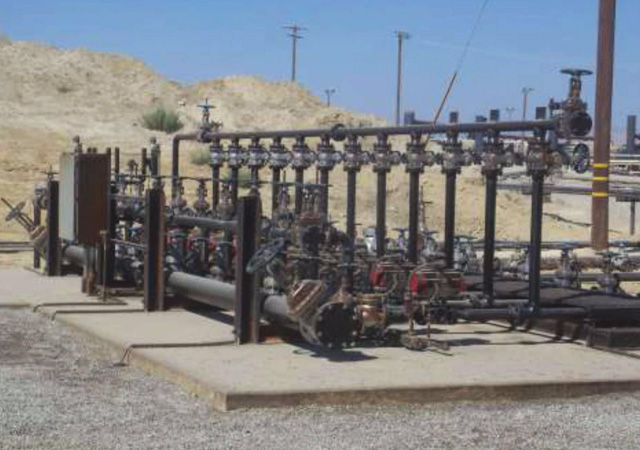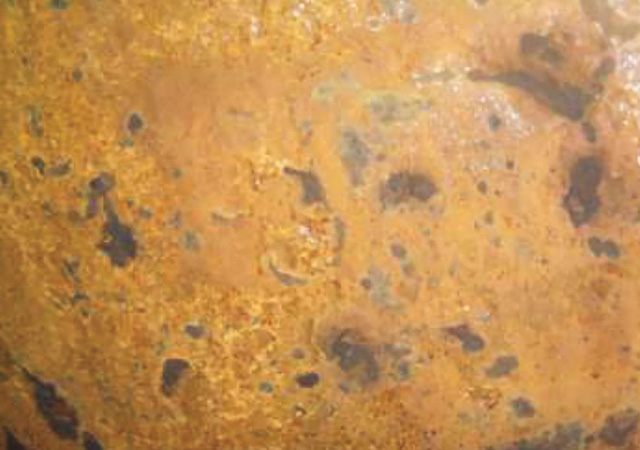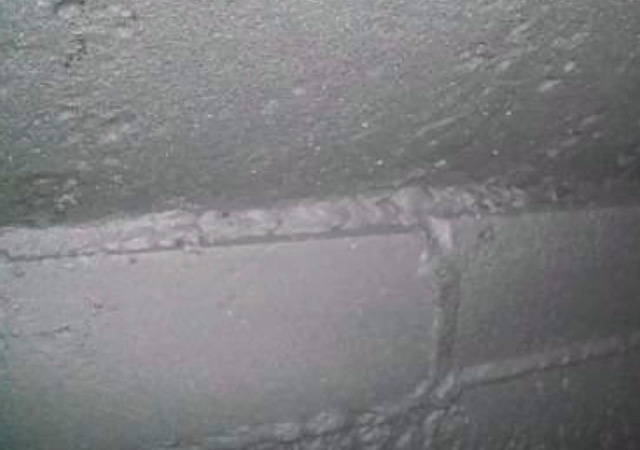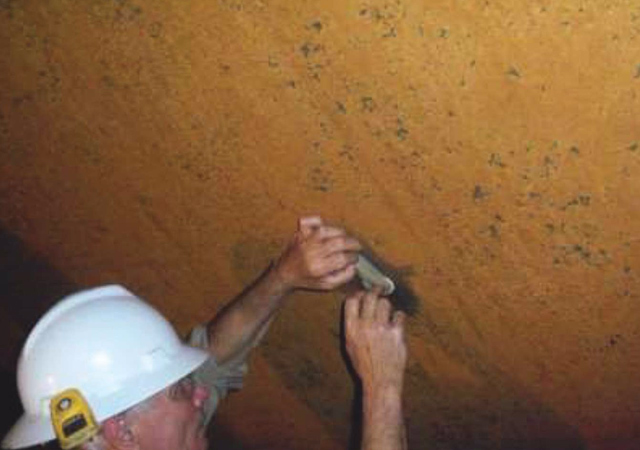Failure of a produced water storage tank lining within one to two years was common. Poor surface preparation was the main cause. This article shows how proper blasting, salt removal, and the use of a heat-resistant lining material will give the tanks the service life desired by the owner.
This case study provides a historical perspective to demonstrate that giving special attention to surface preparation and eliminating surface contaminants prior to coating can essentially eliminate premature coating failure. The pivotal and critical variables are the rigorous testing for and elimination of surface residual salts. Utilization of advanced inspection procedures is also a major factor. This process leads to the prevention of premature lining failures.
 This is the case history of one of several major oil producers in the San Joaquin Valley, whose core competency is thermally enhanced production and recovery from various oil fields in California. The company’s significant asset base produces a large share of the heavy, viscous oil extracted through steam injection in one of California’s most prolific producing areas. Oil fields with low-gravity crude oil are steam flooded (Figure 1) with softened
water injected into production zones. With the heat, the oil becomes less viscous, allowing it to be pumped to the surface along with formation water and water condensate.
This is the case history of one of several major oil producers in the San Joaquin Valley, whose core competency is thermally enhanced production and recovery from various oil fields in California. The company’s significant asset base produces a large share of the heavy, viscous oil extracted through steam injection in one of California’s most prolific producing areas. Oil fields with low-gravity crude oil are steam flooded (Figure 1) with softened
water injected into production zones. With the heat, the oil becomes less viscous, allowing it to be pumped to the surface along with formation water and water condensate.
The crude oil and water mixture returning to ground level at temperatures of ~160 °F (71 °C) goes through a separation process. The water is typically accumulated in 5,000- to 10,000-bbl (795,000- to 1.59 million-L) produced water tanks. These steel tanks store valuable recovered water and are found all over the producing areas of the San Joaquin Valley, which until recently represented almost 10% of all crude oil produced in the United States.
Since the crude oil is nitrogen rich, it has significant levels of naphthenic acids, and contains an average of 1.1% sulfur. It is common for the water held in the produced water tanks to have significant levels of chloride, nitrate, and sulfate soluble salts, and a pH value of 6.8. This high concentration of anions occurs because the geological formation waters are typically salt brine—similar to seawater. It is also common that acidic gases (such as hydrogen sulfide [H2S]) are recovered along with the production of the oil and water, which lead to corrosion in the vapor spaces of the tanks. All of these factors require the application of a complete, durable internal lining of tanks as a corrosion prevention measure.
History
California has been vital in meeting the energy needs of the United States. The 2 billionth barrel was produced in 2007 from reserves calculated at 60 billion bbl (9,540 billion L). These oil fields are some of the oldest and most prolific. In Kern River, a small area of central San Joaquin Valley, oil was discovered in 1899. In 1960, in situ steam recovery began and has since been expanded and made dramatically more efficient to remain competitive with the swings in global oil prices. Thermally enhanced oil extraction had its inception in this area and experience here has been transferred to the tar sands of northern Alberta, Canada and the heavy tar oil fields of Venezuela. Kern County continues to produce low-gravity oil at a rate of ~550,000 bpd (87.4 million L/d).
Coating Specification Revision
Prior to 2003, the company’s surface preparation specifications for produced water tank lining projects required only a white metal blast, repair of pits, surface testing by conductivity for residual contaminants, and coating with a thermally tolerant lining. The surface area for preparation involved the entire tank interior, including the roof, or ~7,500 to 9,500 ft2(697 to 947 m2). The common experience was that the coating system would fail in less than two years, with many documented cases of coating failure in less than a year. Various thin-film coatings had been used and it was originally thought that the coating systems were unable to tolerate the rising operating temperatures, which increased incrementally through the years as thermal injection became more efficient. More robust thin-film, solvent-based, and thermally resistant coatings were applied, yet failures continued unchecked. Forensic analyses of failed coatings indicated 12 to 16 mils of dry film thickness; however, it was not the coating that was intolerant to the service but rather inadequate surface preparation that led to osmotic blistering and spot coating failures (Figure 2). Modification of surface preparation
methods by incorporating the use of ultra-high water pressure blasting did not resolve the problem.

The company worked closely with Bay Area Coating Consultants (Modesto, California), an industry-recognized third-party consulting and inspection firm, to change its specification, and tendered it for contractor bidding in August 2003. The initial changes included testing for chloride, sulfate, and nitrate ions immediately after white metal abrasive blasting or ultrahigh pressure (UHP) washing. Special attention was given to testing around weld seams and where metal loss or pitting was apparent. These were the locations where forensic analysis of coating failures showed the largest number of osmotic blistering and coating degradation. Other changes instituted were post-cleaning, use of 100% solids material, more aggressive anchor profile and blast cleanliness, use of climate control equipment, and prequalification of application contractors.
Given the anion concentration in the produced water stored in the water tanks, the chloride, sulfate, and nitrate ions were prevalent on the metal surfaces and tested at double-digit µg/cm2 levels or above, even after the white metal abrasive cleaning or 40,000 psi (276 MPa) pressure washing. Educating contractors and ensuring the specification requirements were followed were key factors for ensuring the success of the process. The inspectors were hired as a third party to document compliance with the specification; and they were also tasked with monitoring the deionized water used in the wash process and testing the abrasive material to make sure anion concentrations of both media were within acceptable limits.

The Revised Work Process
The recoating of a produced water tank can take several weeks. After taking a tank out of service, all surfaces are cleaned to remove oil, grease, and sediment using a >3,000-psi (21-MPa) pressure washer and an acceptable surface degreaser in accordance with API 653.1 Welding and structural repairs follow. The next step is a thorough commercial blast using an abrasive with specified limits of 4 ppm chloride, 20 ppm nitrate, and 20 ppm sulfate. These limits are confirmed with the CHLOR*TEST “CSN”† test kit to ensure salt contaminants are not added to the surface.
After the initial abrasive blast, CHLOR*RID† is used as the soluble salt remover. It is applied with a 35,000-psi (241-MPa) UHP washer with a spinner nozzle to the entire internal surface of the tank in a diluted solution with a ratio of 1:100 salt remover/water.
New tanks do not require UHP and pressure can be reduced to 5,000 psi (34 MPa). Surfaces are then abrasive blasted to NACE No. 1/SSPC-SP 52 (white metal) (Figure 3) and followed by surface testing to ensure the salt limits have been met. The test kit is specified for testing surface chloride, nitrate, and sulfate ions. The limits are non-detectable levels of chloride, 5 µg/cm2 for nitrate, and 5 µg/cm2 for sulfate. The anchor profile required is 2 to 4 mils (51 to 102 µm) (Figure 4).
A rigorous review of comparative project costs to determine the impact of the specification changes to ion-specific testing and incorporation of salt decontamination determined there is no added incremental cost. The ion-specific testing and test kit provide one decontamination step (Figure 5) to replace inadequate conductivity surface testing and multiple high- pressure washes with an undetermined outcome.

Enviroline 405HT†, an epoxy novolac high-solids coating, proved to be thermally tolerant at operating conditions with temperatures of ~160 °F (71 °C), and allowed temperature excursions up to 190 °F (88 °C). It was first used on a produced water tank in late 2004. To be applied properly at 20 to 40 mils (508 to 1,016 µm) (Figure 5), the plural-component coating requires a learned technique.
No coating failures occurred within 10 years after initiating the new regimen of critical surface preparation that tests for and removes residual soluble salts. This is a dramatic change from the previous average of two years between maintenance recoats. The successes of corrosion mitigation and dramatic cost reduction for produced water tanks have been impressive. The direct cost for recoating a produced water tank as part of a corrosion mitigation project averages between $170,000 and $250,000, depending on tank size. By increasing the corrosion protection from about two years to almost 10 years, this represents a savings of ~$1,000,000 in nominal terms for a 5,000-bbl tank. More importantly, it can be expected that these coatings will last a minimum of 20 years, which doubles the savings.

The indirect costs related to such a project are more difficult to quantify but important to consider. Reduced management overhead, less tank downtime and a reduction in lost or deferred oil production, and lower environmental waste disposal costs due to improved life cycle coating performance are all very real. Additionally, the environmental impact of mobilizing crews to conduct frequent maintenance recoats has been reduced. Loss of revenue associated with a shut-down in crude production (if the tank was in service prior to the maintenance coating project) is a prominent factor to consider and a motivator to return the tank to service expeditiously. These additional avoided costs and loss of revenue exponentially magnify the financial incentives associated with initially giving critical attention to surface preparation.
Conclusions
The cause of early lining failure in the produced water tanks was determined to be improper surface preparation. The revised coating specification required proper blasting, salt removal, and the use of a heat-resistant lining material. The work provided the owner with a long-lasting lining and saved the cost of relining the tanks every few years.
†
Trade name.
References
- API 653, “Standard for Tank Inspection, Repair, Alteration and Reconstruction” (Washington, DC: API, 2013).
- NACE No. 1/SSPC-SP 5, “White Metal Blast Cleaning” (Houston, TX: NACE International).